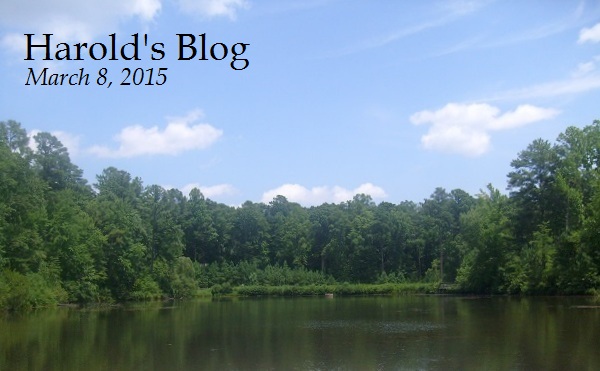Harold’s Blog: Construction & Imagine Cary
Cary, NC — This week was a busy week, as the town council and staff began holding some of the meetings that were postponed from two weeks of snow.
Monday
My first event of the week was on Monday at Kingswood Elementary, where I participated in Read Across America Day. I visited a 5th grade class of STEM students and read a small book written by Jamie Lee Curtis. Afterwards, I answered a couple dozen questions.
Some of the easy questions included my favorite sport, color, subject in school, etc. Some of the more sophisticated questions included town recycling efforts and the town’s involvement in the building of the Mayton Inn. My entire visit was less than an hour. I had a wonderful time and hope to get invited back in the future.
Google Fiber Huts
Later in the day, I met with the town manager for our weekly one-on-one meeting. Most of our time was spent talking about the upcoming placement of Google Huts around town. From my understanding, these huts are necessary as a type of junction point for the fiber.
The huts are roughly 14 feet by 22 feet and have been made of precast concrete in other cities. They will be located on town property. Since these aren’t attractive structures, it will be our hope to get them appropriately screened.
Technology and Budgeting
Other items the town manager and I discussed included technology and the upcoming budget. The budget will once again be challenging this year with requests far outpacing our operational capacity. This is, of course, exacerbated by the NC legislature which continues to take revenues away from municipalities.
In addition, Cary is scheduled to have a two cent increase in taxes this year as part of the 2012 Bond Referendum. If we are able to create a budget at that tax rate, we will likely continue to have the lowest tax rate in the county.
Tuesday
Tuesday I met with lawyers, the town manager, the deputy town clerk, and town finance people to sign bonds that were sold as part of the 2012 bond referendum. These bonds were purchased mostly by large insurance companies who spent millions.
Imagine Cary Work Sessions
Tuesday night the council held the first of two work sessions planned for the Imagine Cary’s second phase to provide direction in six major plan areas. Before we began the work session, council went into a closed session to talk about economic development and a law suit.
The remaining hour and 15 minutes was spent on Imagine Cary. At this work session we focused on three of the four general policy topics. Council provided feedback and agreed to the following general policies under the three topics.
Where we would live
- Recognize and preserve the quality and character of existing residential neighborhoods as they mature and change over time.
- Provide opportunities for a greater variety of housing types within new residential neighborhoods.
- Provide the greatest variety of housing opportunities, housing types, and densities within mixed-use activity and employment centers.
- Support new residential development on infill and redevelopment sites that is designed to acknowledge the context of its surroundings.
- Maintain Cary’s existing supply of affordable housing and encourage the development of new affordable housing units in suitable areas throughout Town that are proximate to services, transit, and employment.
Where we would work
- Reserve and provide sites for employment and economic development – especially for major industries or employers – within Cary’s existing traditional suburban office and industrial parks.
- Incorporate commercial and housing uses into selected suburban office/industrial parks, evolving them into mixed use employment centers.
- Reserve and provide sites for employment and economic development opportunities within a targeted set of new or existing mixed use activity centers.
Where we would shop and dine
- Facilitate the redevelopment and revitalization of Cary’s aging or poorly-performing activity centers. Redevelopment of older centers is preferred over the development of new activity centers.
- Focus commercial, retail, dining, and entertainment uses within existing and planned Mixed Use Activity Centers.
- Support the development of a limited number of centers that have higher densities/intensities, are transit supportive, and have the greatest potential to be high-functioning, premier centers.
At our next Imagine Cary work session on March 24, 2015, we will focus on the last general policy topic, the southwest area, and the downtown area.
Wednesday
Wednesday, I talked with a group of high schools students who were part of the Cary Chamber’s Youth Leadership Program. They were spending the day learning about local government, touring various parts of town, and listening to various government speakers. I told them about my duties as mayor and then answered questions for about 10 or 15 minutes.
State of the Town Address
About an hour later, I gave the State of the Town address to the Cary Newcomers Club at their 30th Anniversary meeting. There were over one hundred people, mostly ladies, in attendance. I talked from power point slides that were very similar to the ones I presented at the Cary Chamber in January. Then I answered about a couple of dozen questions. My presentation seemed to be well received. I do hope they invite me back in the future.
Thursday
Thursday, Cary was once again threatened with inclement weather. After consulting with staff, we agreed that it would be a rain event and decided to proceed with four annexation public hearings and two quasi-judicial hearings. The four public hearings had no speakers.
Quasi-Judicial Hearings
The first quasi-judicial hearing was for 70 homes in a subdivision along Indian Wells. The main purpose of the hearing was to allow a payment-in-lieu for construction of a portion of Highcroft Drive. Since there was no other part of that road to connect to, the DOT decided not to permit them to cross a stream which they were required to do as part of the town ordinance.
So, the council agreed to allow this payment, especially since they had no other choice. Additionally, they wanted to use a retention wall as part of their edges for stormwater management, which council also allowed. Their final issue was to remove one of seven champion trees on the property. Since it was a sweet gum tree, which is a lower-tier tree, council agreed for the removal and replacement of this tree.
Our second quasi-judicial hearing was tabled at their attorney’s request.
Friday
Friday I participated in the weekly Metro Mayors legislative update. About two dozen mayors and representatives from municipalities participated. Here are some of the bills introduced this week in the legislature that could impact Cary:
- Exempt from property tax the increase in value of real property held for sale by a builder to the extent the increase is attributable to subdivision or improvements by the builder. It also changes the definition of builder from a general contractor to a taxpayer.
- Boost the film grant program’s funding to $66m in recurring funds. The fund may be too high for independent filmmakers to participate.
- Increase the cap on turnpike projects from nine to eleven pending approval of Metropolitan Planning Organizations.
- Allow 5% of voters in a city to petition to require a vote of the public on typically non-voted debt.
- Change the Wake County Commissioners from running at large to running in districts and increase the size of the Commission.
- Create a fund to provide loans to local government units for the development of sites and buildings.
- Phase out some of the transfers from the highway fund over five years starting in 2017-18 and finishing in 2021.
Additionally our briefing and discussion also included the following points:
- No bills have been introduced for tax reform.
- An economic incentives bill passed from the house to the senate. It includes a JDIG expansion, increases disbursement to the rural Utility Account, requires urban local government to participate with local incentives, increases requirements for urban job creation, allows the Utility Fund in rural areas to do job retention in addition to job creation, allows businesses to pay taxes only on sales within North Carolina, a jet fuel tax exemption, and a datacenter sales tax exemption on electricity.
Our meeting concluded after about an hour.
Saturday
Saturday, I gave welcoming remarks at the annual meeting of the North Carolina Train Hosts Association. These men and women are part of more than 100 volunteers from across the state serving as goodwill ambassadors on the Piedmont and Carolinian trains.
Train hosts volunteer their time to ride the trains to assist passengers, promote passenger services, and answer questions about the route, ground transportation, and area attractions. Each one of these volunteers completed a one-day training session and committed to making at least one host trip every 60 days. What a great group.
Emails from Staff
Emails from staff this week included an update on bid awards for the Academy Street project and the Downtown Park project. The Academy Street project received only a couple of bids, so the town is rebidding the project. The downtown park project did not receive bids.
Academy Street Delays
The schedule is being impacted by these delays. Staff will be looking at how bid delays will impact the overall schedules. In addition, with less competition, the price has a tendency to go up. Recently, bid prices have already increased significantly for other projects. Staff will continue to look for ways to lessen the impact on the schedule and keep the costs as low as possible.
Construction Activity Report
Staff also provided an email with February’s construction activity report. Here are some of the notable points:
- In January, single family permits were down 3.1% nationally, down 9.2% statewide, and down 4.9% in Cary from the previous month.
- 43 new Certificates of Occupancy were issued for single family homes in 20 neighborhoods last month.
- 7 new Certificates of Occupancy were issued for 199 multi-family units.
- Cary had 15% of the new single family permits in Wake County last month.
- 30.42 acres were annexed into Cary in the month of February.
- The average single family home was 4,281 square feet in February compared to 3,603 square feet in February of 2011.
Plans under review since the beginning of the year include:
- 4 modular classrooms at Mills Park Middle School.
- 27 townhomes in Waterford at Cary Park.
- 20,184 square feet of office and 2,876 square feet of retail on Chatham Street.
- A 9,600 square foot restaurant at Cary Town Center.
- 19 single family homes on Stephens Road.
- 32 single family homes on Indian Wells Road.
View all the plans under review.
Emails from Citizens
Emails from citizens this week included kudos for help with a plumbing issue, a request for help with a school issue, and a request to honor an achievement of a student.
Get in Touch
Next week, we will try and get back to normal and hope that the weather will be nice. My activities include several meetings, a council meeting, being a guest reader at Farmington Woods, making remarks at the Tobacco Road Marathon, and attending the Basant Bahar at the Cary Arts Center.
Well, that is all for this week. My next post will be on Sunday, March 15th. Although I have Facebook and Twitter accounts those are not the best means of communications with me. Please send all Town of Cary questions or comments to Harold.Weinbrecht@townofcary.org and email personal comments to augustanat@mindspring.com.
———————————————————————————————————————————-
From the blog of Cary Mayor Harold Weinbrecht. Photo by Jessica Patrick.




Google huts: why not consider making some or all of them into public art rather than screening them? Turn local artists loose on them. Let them paint people, landscapes, scenes or just textures (faux brick, wood, stone, or other designs) on them.
This is done in San Jose, CA with utility boxes. Rather than trying to hid something unsightly, we could turn these into something pleasant. Bet the Public Art Advisory Board could weigh in.
My sense, based on our story What’s a Google Fiber Hut, is that they are trying to be unobtrusive, quite likely for security reasons. No visible signage or branding in the photos we saw.
The photo in the story screams “obtrusive” to me. My point is that we can acknowledge that the huts are ugly, and so we can either try to hide them or make them less ugly and perhaps actually visually interesting. Either can be done while still keeping the huts secure.
P.S. Could do the same with some of the utility boxes around town too.
Town Planning Staff and the paid Imagine folks oughta keep an eye on the housing over retail being built in neighboring Park West Village.
See how soon the tenants fill it up! The rest of the development sure looks quite occupied.
Two stories are being built over retail in the center of the development. Reminds me of the excellent physical fitness facilities at The Bradford with housing above.
All that Park West Village needs is a train stop!